Currency index
Advertisements
One-hundred Swiss franc note(Eighth series)

Quick links to banknotes
Ninth series:






Eighth series:





Description:
Size: 74 x 159mm
Main color: Blue
Date of issue: 1 October 1998


One-hundred Swiss franc note(Eighth series) design features

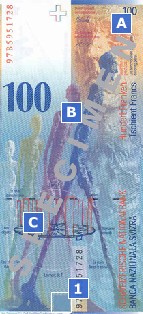
Obverse
The portrait of the front side of 100 franc note shows Alberto Giacometti (1901- 1966), one of the most important 20th century's sculptors. His international renown is founded on his sculpture, but he also produced notable paintings and drawings. Although Giacometti rose to prominence in the Paris of the thirties as one of the leading members of the Surrealist movement, it is the work produced after the war that constitutes his great artistic legacy. The sculptures of slender, elongated human figures epitomize the distinctive Giacometti style. The core of his oeuvre is a representation of man's existential solitude and angst, in which he tried to capture reality in all its complexity.
[1] Microtext

Reverse
[A] Lotar II (1964)
[B] Homme qui marche I (1960)
[C] Composition "Aubette" 1927

Security Features(combined security concept of 8-th series Swiss franc notes)


Obverse
[A] The magic number


Security feature [A] shows the denomination of the banknote printed in a shimmering transparent color. It is especially easy to see when the light falls on the feature at a particular angle.
Test: Hold the banknote like a sheet of paper you want to read. If you cannot read the magic number, tilt the note slowly towards the light until it appears.
[B] Watermark digits
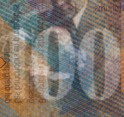
Security feature [B] is a watermark in the note paper reproducing the denomination of the note.
Test: Hold the note up to the light. If you look closely, you will see the watermark digits beneath the color printing.
[C]Intaglio digits: The colored number

As security feature [C], the denomination of the bankonote is produced by an intaglio process. It is rough to touch and leaves traces when rubbed.
Test: Rub the colored number on a sheet of paper. The ink leaves distinct traces.
[D] The perforated number

The denomination is made of very fine perforations.
Test: When held up to the light, the denomination is seen as perforated surface.
[E] Optically Variable Ink(OVI) The chameleon number


As security features [E] the denomination of the Swiss franc note is printed with special ink. The chameleon number chanages color whenever the light falls on it from a different angles.
Test: Hold the banknote like a sheet of paper you want to read and look at the chameleon number. Tilt the note slowly away from you or towards you, and you will see the color of the chameleon number change.
[F] Ultraviolet digits

As security feature [F] the denomination on the left edge of the note appears dark under UV light and brightly fluorescent on the right side.
Test: You need an ultraviolet lamp to see a dark UV number on the left-hand side and directly opposite a bright fluorescent figure. At the same time the left side of the portrait is brightly fluorescent and the right side is dark.
[G] Metallic digits: The glittering number
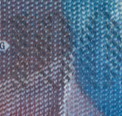

As security feature [G], the banknote denomination is reproduced in metal-coated form.
Test: Hold the banknote like a sheet of paper you want to read. When you move it, the number has a silvery glitter. Under a magnifying glass you can see the monogram of Swiss national bank SNB BNS in the glittering number.It is partially covered by ink.
[H] Tilt effect

As security feature [H], the banknote denomination is printed in such a may that it can only be seen from an unusual angle.
Test: Hold the note horizontally at eye level so that you can see the front of the note at an extremely sharp angle. Now you should be able to see number appear.
[1] Transparent register

[2] Watermark portrait

In the top-right hand corner on the front of the Swiss franc note, a watermark portrait can be seen looking at the same direction as the printed portrait.
[3] Guilloches

The fine entwined lines can change color from line to line or within the line itself.
[4] The moving number

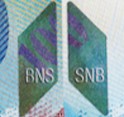
In the middle of the note is the Kinegram®: the banknote denomination, shown on spatial silver foils, appears to move. Two other smaller Kinegram® show the Swiss cross and the monogram of the Swiss National Bank: SNB BNS. The form of the Kinegram®, the positioning of two smaller Kinegram® and the movement of the numbers differ from denomination to denomination.
Test: Check he paper and raised print Kinegram®. The moving number appears to run across the Kinegram®. The Swiss crosses and the monograms also seem to move.
[5] Microtext.
On both sides of the banknote, a short text about the person portrayed is reproduced in a print so small that a powerful magnifying glass is needed to read.
[6] Symbol for the visually handicapped

A symbol is perceptible to the touch and different for each denomination is embossed at the lower end of the front of each note to enable the blind and vision impaired to recognize the face value.
Reverse
[1] Serial number

Each Swiss franc note bears a serial number in two different places and two different colors. The serial number is a combination of letters and digits.
[2]Security thread
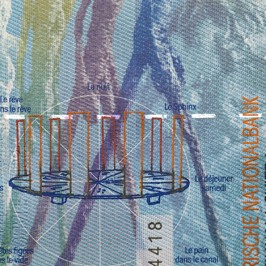
A metallic thread is embedded in paper and emerges as a series of silver dashes on the back of the Swiss franc note. When held up to the light, the thread appears as a bolt continuous line.
[3] Microtext

Microtext. On both sides of the banknote, a short text about the person portrayed is reproduced in a print so small that a powerful magnifying glass is needed to read.
Sources:
snb.ch
wikipedia.org




Follow currencyguide.eu